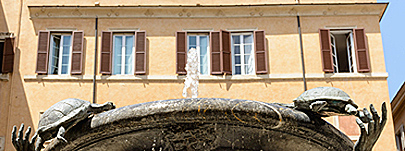|
Navona - Campo de' Fiori
The Turtles' Dream
Rome sights seen from the panoramic terrace - roof garden
|
Elegant, bright panoramic 4 bedroom apartment, in historical stately palace overlooking the Turtle Fountain.
4 ample double bedrooms, 3 bathr., amazing frescoed sitting room w. antique coffered wooden ceiling, large dining-kitchen, 2 fitted terraces of which one panoramic with views of Rome's sights and domes.
High ceilings, tasteful furniture, modern appliances, all mod cons. Inviting, cozy and charming property, accommodating max. 8 persons in real beds.
- Elevator;
- Air conditioning / heating in each room;
- Internet Wi-Fi high speed internet;
- Colour TV with international and English/American channels;
- Complete kitchen equipment, finest dishes, glassware;
Washing machine, clothes dryer, iron, iron board, dishwasher;
- Microwave, mixer, toaster, electronic scales;
- Italian coffee pots, American coffee percolator, tea kettle
- Baby stroller, SAFE;
- Detailed property and area booklet with photos, map;
- Nearby: grocers, shops, cafes, restaurants, delis, hammam & massage, beauty centre, hairdresser, jogging & bike track.
|
|
To Rome centre map, for the exact location.
Visit also:
|
The Turtles Dream apartment is endowed with a wonderful panoramic terrace / roof garden, where you enjoy views of Rome's sights and domes. Click here if instead you want to see the photos of the terrace and of its features (dining table with chairs, sitting area, parasol, deck chairs, plants etc.)
TURTLES DREAM TERRACE VIEWS |
 |
In the following photos you can see some of the sights that can be seen from the terrace. Please bring your binoculars to enjoy them all! |
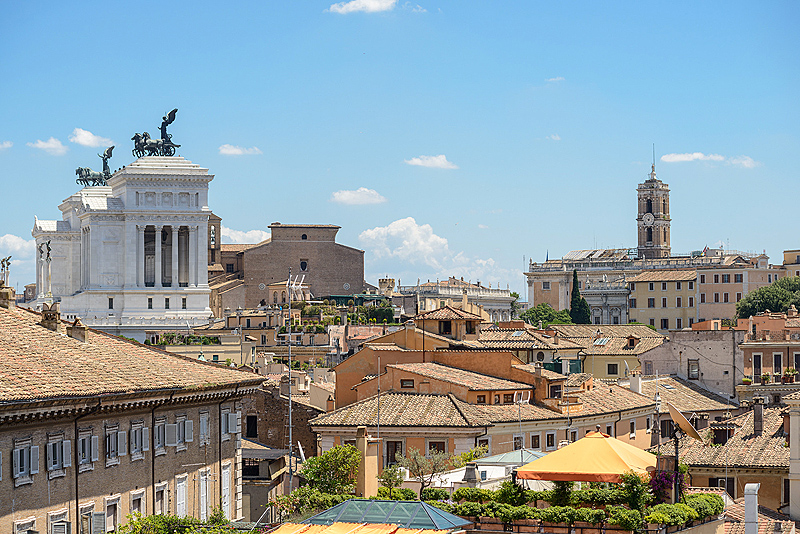 |
| South view, from left to right: the Vittoriale monument, also called Altar of the Fatherland as it hosts the unknown soldier of WW1. It was built to celebrate the reunion of Italy occurred in 1861, although building of the monument ended in 1937. Its construction was controversial, as many old churches and ancient Roman monuments had to be destroyed in Capitol Hill. After the Vittoriale, to the right, you see the Church of Ara Coeli ("Altar of the Sky", in Latin). It was built to replace the temple of Juno, dear to ancient Romans because its geese alarmed of the impending attack of the Goths, saving Rome. |
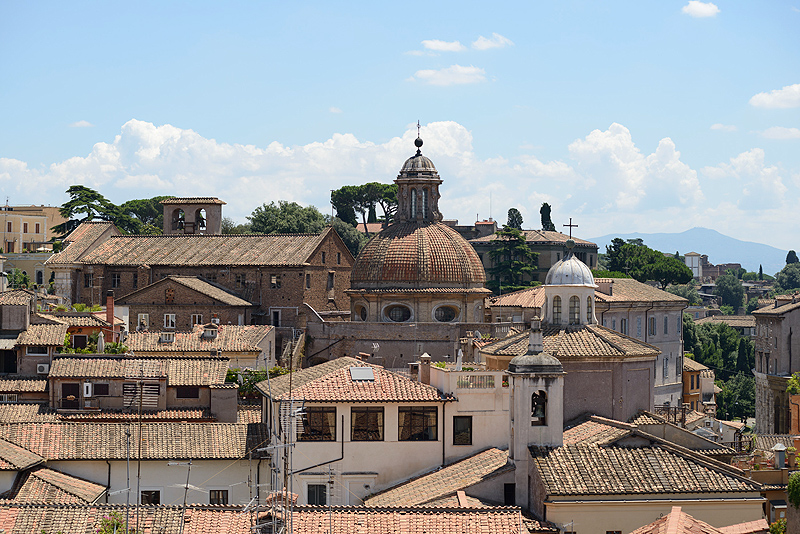 |
| South view: the Church Santa Maria in Campitelli with its round dome (centre-left, foreground), and the octagonal dome of the Abbey of Sant'Ambrogio (Saint Ambrose, centre right, foreground). Behind them there is the Palatine Hill, and in the distance on the right side you can see Monte Cavo, of the Alban Hills or Castelli Romani (site of the Temple of Jupiter of the ancient Latins). |
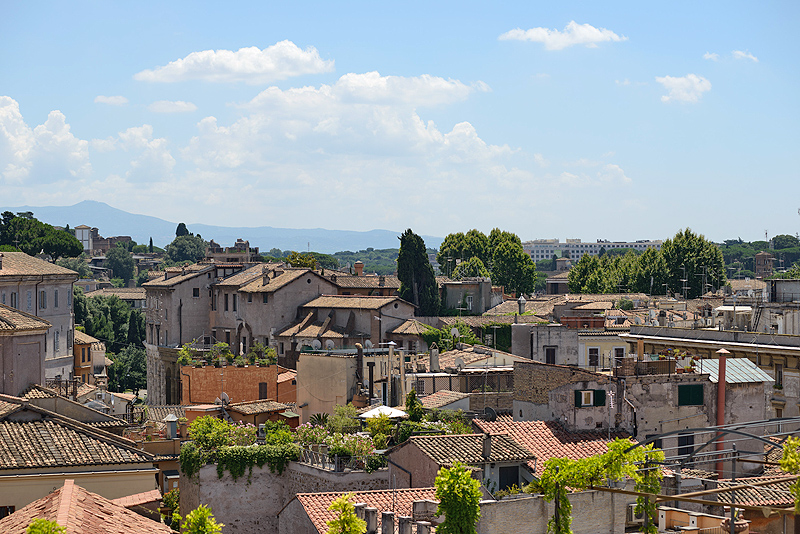
|
| In the foreground: on the left side you see the remaining structure of the Threatre of Marcellus, within which during the Middle Ages houses were built. In the background you see the silhouette of the Roman Castles or Alban Hills, in particular of the Lake of Albano and of Castel Gandolfo, the summer residence of the Pope. To the right you also see the FAO building (Food and Agriculture Organization), a United Nations institution. |
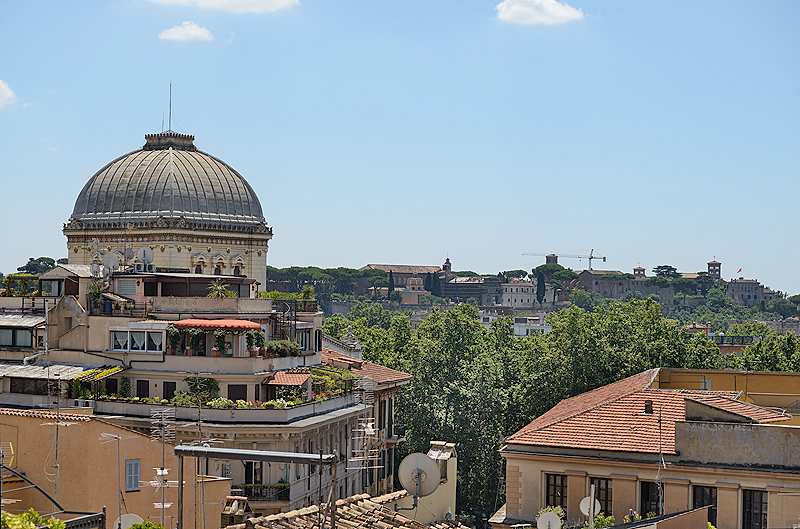
|
| The dome of the Jewish Synagogue or "Il Tempio" (The Temple), as the Roman Jews call it, and to the right the Aventine Hill, with the Church of San Saba and the Palace of the Knights of Malta, with their flag hoisted. |
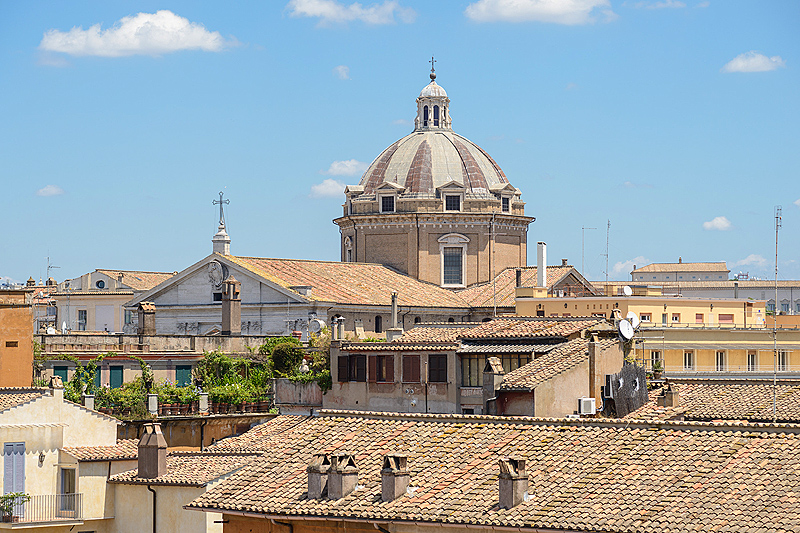 |
| The Chiesa del Gesu' (Church of Jesus, 18th century), the main church of the Jesuit order. |
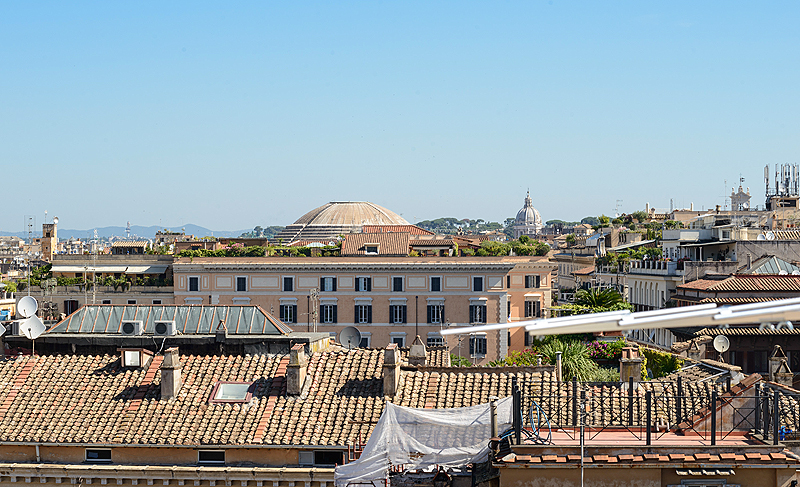 |
| The dome of the Pantheon, the best preserved monument of antiquity. It is still the largest dome in Rome with its 43,3 meters diameter (app. 140 Ft.). To its right you can see the dome of the Church San Carlo al Corso, near the Spanish Steps. In the background you also notice the pine trees of the Borghse Gardens, and in the distance the Monti Simbruini encirling Rome to the north. The turret to the right is part of Palazzo Montecitorio, the seat of the Italian parliament. |
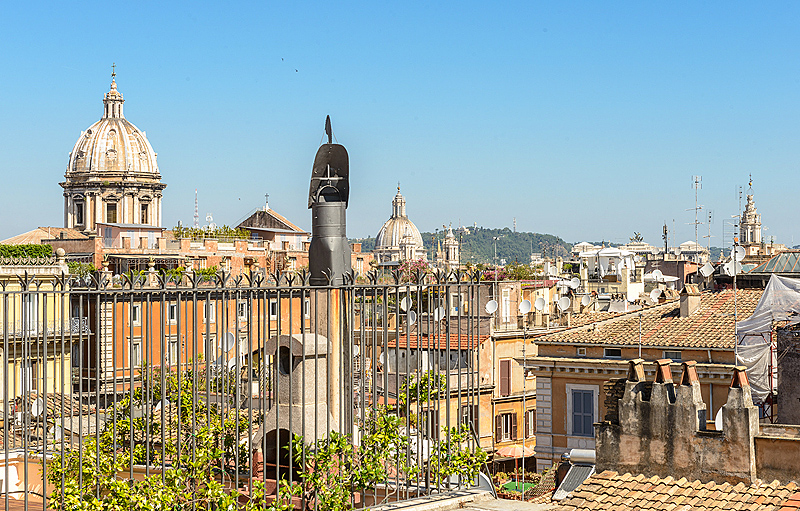 |
| North / North-West view, from left to right: Church of Sant'Andrea della Valle, Church of Sant'Agnese in Piazza Navona, with its two front belfries. In the distance you can see the Monte Mario hill with its astronomical observatory. As you continue looking towards the right, you will see the imposing Palace of Justice, and finally the shell-like dome of the Church Sant'Ivo alla Sapienza. Both churches were designed by the genial architect Francesco Borromini. |
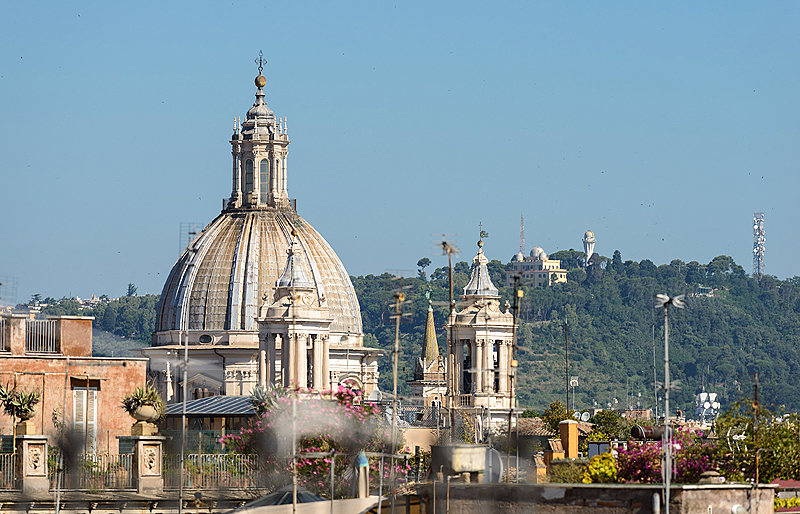 |
| A closer view of the dome and of the two belfries of the Church of Saint Agnes, overlooking Piazza Navona. Between the right belfry and the dome you can single out the belfry of the Church Santa Maria dell'Anima, nowadays the national church of the Germans in Rome. In the distance you can see the Monte Mario hill, site of the Astronomical Observatory, and also of TV stations repeaters. |
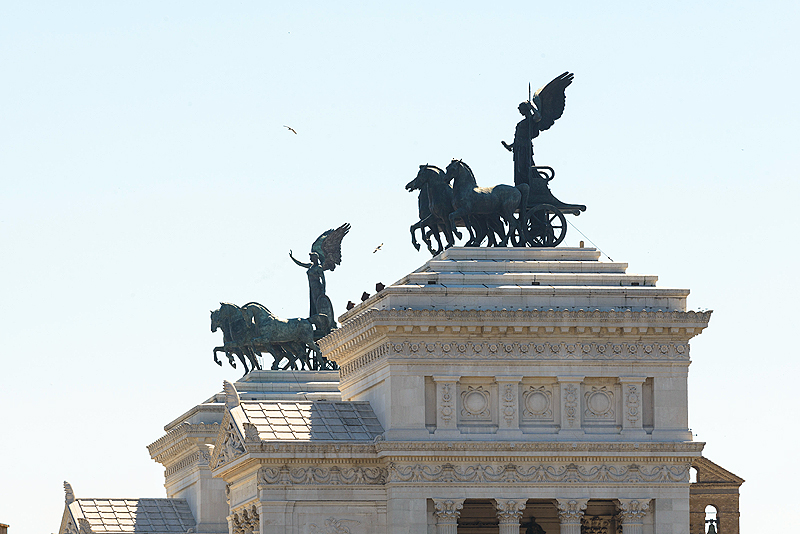 |
| View of the "Quadrighe", or four horses chariots, on top of the Victor Emanuel monument, symbolizing Victory in the Independence Wars. They are 10 Mt. high (app. 33 Ft.), and the entire monument is 81 Mt. high (app. 266 Ft.). Photo taken with a moderate teleobjective, equal to simple binoculars. |
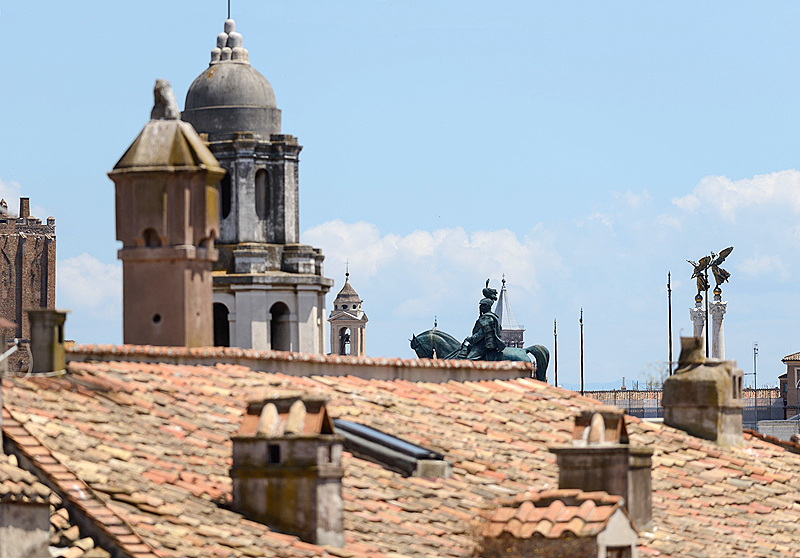 |
| The equestrian statue of King Victor Emanuel II, which is part of the Vittoriale monument, emerges amidst the chimneys and the belfries (photo with a moderate teleobjective, similar to simple binoculars, the statue is visible with the naked eye). The statue is 12 Mt. high (nearly 40 Ft.). |
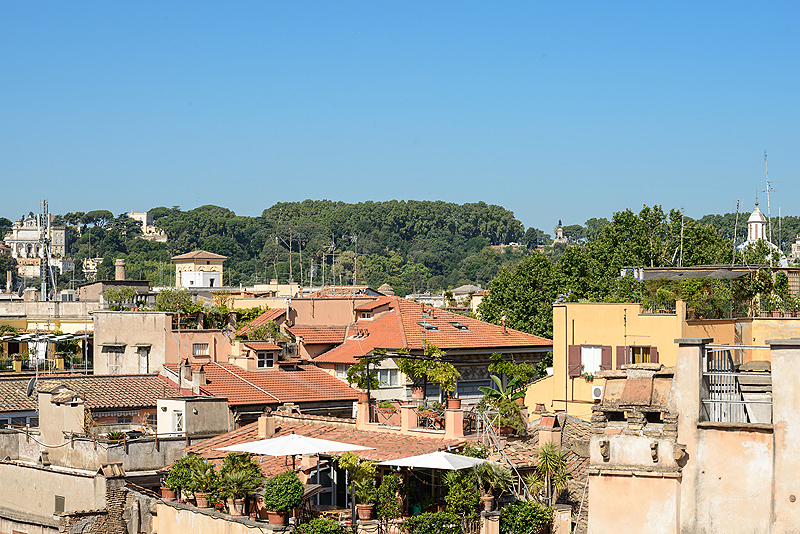 |
| View of the Janiculum Hill, Rome's highest despite it is not ranked among the seven famous hills. It is endowed with a beautiful park, and a stroll within it, or "Passeggiata del Gianicolo", will allow you to have amazing panoramic views of all Rome. |
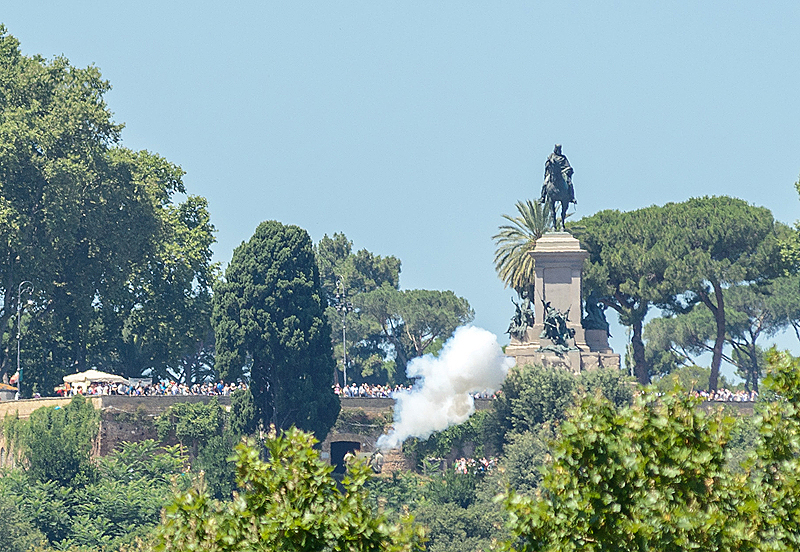 |
| In this photo, you see the cannon firing (blank) every day at noon, beneath the esplanade with the statue of Garibaldi, overlooking Rome. Throngs of tourists watch the ceremony every day. It commemorates the battles of 1849 for independence. On one hand stood the Italian patriots, who proclaimed the Roman Republic (the 3rd, in its long history, after its first inception during ancient Rome) and on the other hand the powerful French army, summoned by Pope Pius IX, who had fled town. It took five months of bloody battles before the French Army, a superpower of the time, captured Rome. Eventually in 1870 Rome was conquered by the newly born Italian army. This photo was taken with a moderate teleobjective, however at naked eye you can see the same scene from the little ladder present in the terrace. |
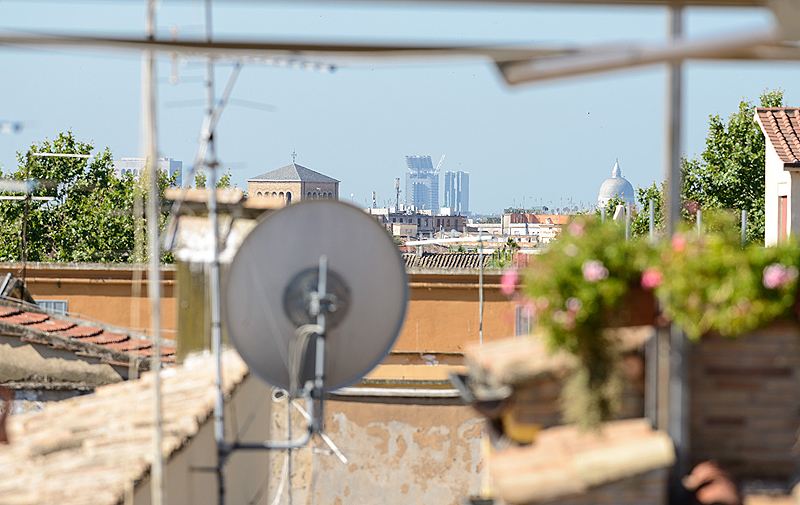 |
| View towards the EUR, the futurist quarter build by the Fascist regime to host the 1942 world expo (EUR = Esposizione Universale Roma), which was never held because of WW2. It has an interesting architecture. In the photo you can see in the distance from left to right: the "Square Coliseum", the two skyscrapers which exceptionally were allowed by the Roman authorities (by the law, no building in Rome can be higher of St. Peter's dome), and finally the dome of the Church St. Peter and St. Paul at the EUR. |
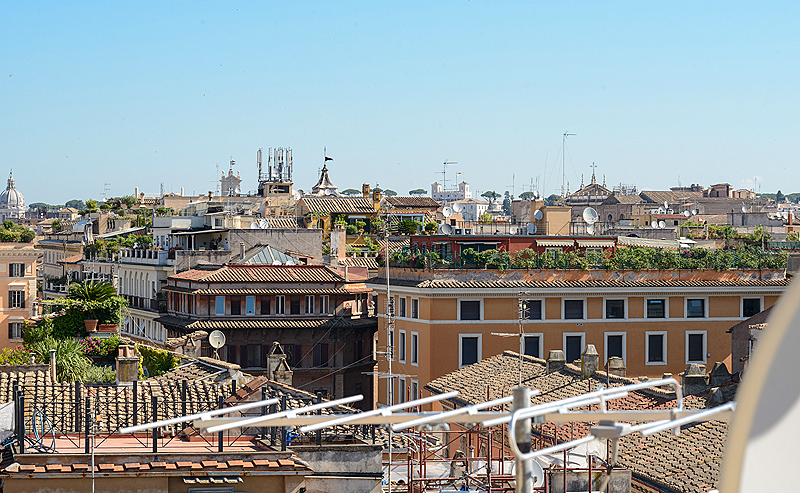 |
| East general view. You can single out from left to right: the dome of San Carlo al Corso, the turret of Palazzo Montecitorio (the Italian Parliament), the two turrets of Villa Medici within the Borghese Gardens hill, and finally the roof of the Church of St. Ignatius. |
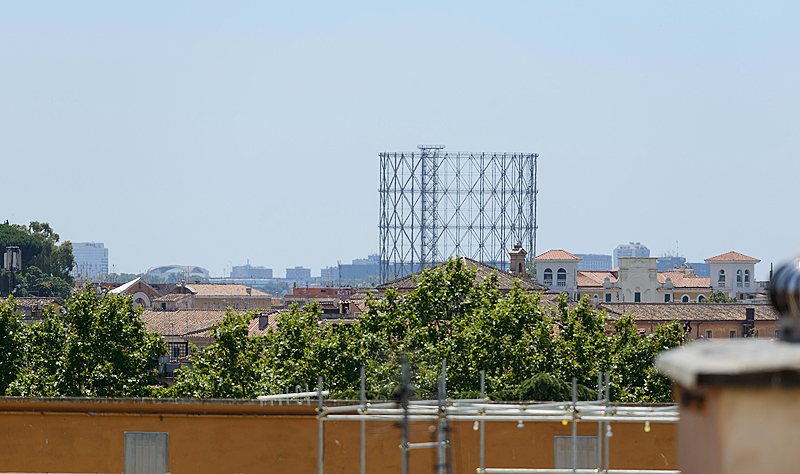 |
| West view, towards the distant "new" quarters (19th century) Ostiense and Garbatella, two former working class quarters, where an attempt was made in the first part of the 20th century to build some factories and their infrastructures. They were working class quarters back then, and they were the heart of the contemporary modern popular Roman culture. Now these quarters are semi-central / central, and they are inhabitated mostly by white collars / middle class. The factories have been transformed into museum monuments about the history of the past period, or are venues hosting cultural events. From left to right you can see in the distance: the imposing palace of the Regional Government of Latium, the Ostiense Train Station, the metallic circular grid of the "Gasometer" (Gasometro in Italian), the former supplying infrastructure of gas, and finally the facade of the former slaughterhouse, nowadays a site where festivals and cultural events are held. |
Left photo: View of Piazza Mattei and of the Turtle Fountain seen from the terrace.
You can compare the same view with the one you can have from the windows of the apartment. |
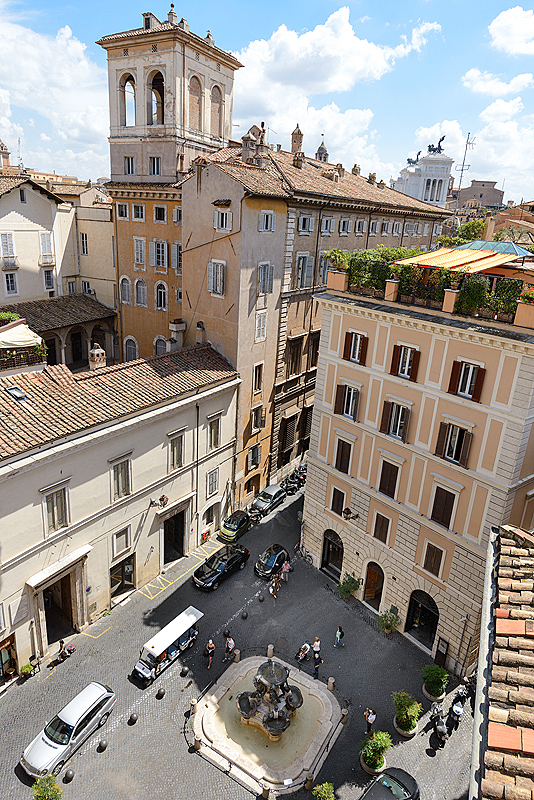 |
For a detailed presentation of the rooms, please go to the INDEX on top of this page
    
Visit Rome | Rome panoramic views | Rome apartments and villas | Inquire | Rome travel guide | Rome map | Service | Resources
Roman Homes homepage |

